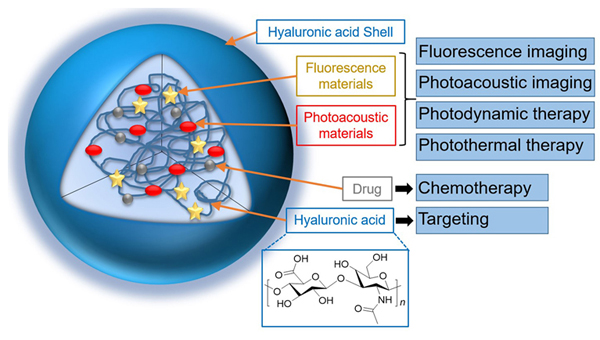摘要/Abstract

荧光/光声成像和光疗技术的生物医学应用引起了人们越来越多的关注, 然而很多荧光/光声造影剂存在生物相容性较差, 缺乏肿瘤靶向性, 信噪比较低, 功能单一等共性问题, 严重限制其诊疗应用. 透明质酸具有优异的生物相容性和主动肿瘤靶向性, 可被透明质酸酶降解, 并且易于化学修饰和实现多种超分子弱相互作用力协同工作. 因此, 人们将透明质酸与荧光/光声造影剂结合制备纳米材料, 使其在细胞乃至活体的标记性能和治疗效果获得了很大的改善. 本文综述了将两类物质结合制备纳米材料的方法, 着重阐述了纳米材料的结构与性能关系, 为其未来设计和开发提供了指导, 最后对存在的主要问题以及未来的重要研究方向进行了分析和展望.
关键词: 透明质酸, 荧光成像, 光声成像, 光热治疗, 光动力治疗
The biomedical applications of fluorescence/photoacoustic imaging and phototherapy have attracted more and more attention. However, many fluorescent/photoacoustic contrast agents have some common problems, such as poor biocompatibility, lack of tumor targeting, low signal-to-noise ratio, single function and so on, which seriously limit their application in diagnosis and treatment. Hyaluronic acid (HA) exhibits excellent biocompatibility and active tumor targeting, can be degraded by hyaluronidase, and is easy to be chemically modified and realize the cooperation of a variety of supramolecular weak interactions. Therefore, HA has been combined with fluorescent/photoacoustic contrast agents to prepare nanomaterials, which greatly improves the labeling performance and therapeutic effects in cells and even in vivo. In this paper, the preparation methods of nanomaterials by combining these two kinds of materials are reviewed, and the relationships between the structure and performance of nanomaterials are emphasized, which provides guidance for their future design and development. Finally, the main problems and important research directions in the future are analyzed and prospected.
Key words: hyaluronic acid, fluorescence imaging, photoacoustic imaging, photothermal therapy, photodynamic therapy
PDF全文下载地址:
点我下载PDF
